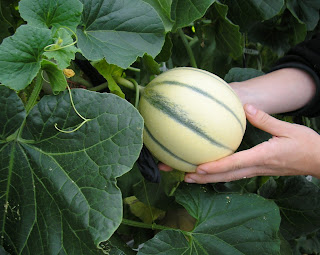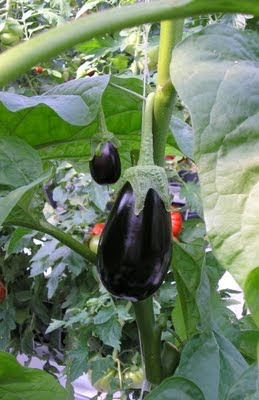Floating Gardens
On a century-old family farm just outside of Saskatoon, a brother and sister team are trying their hand at a modern style of farming. But their goal remains the same as it has been for generations – to help feed the local population.
This is the first season of operations for Floating Gardens, a hydroponic greenhouse operated by Rachel and Chris Buhler. Rachel has a Master’s degree in Plant Sciences while Chris has a diploma in greenhouse management. They have built a huge greenhouse (176 x 144 feet) on the family farm and have started selling their produce at the Saskatoon Farmers’ Market as well as to a few local restaurants and Steep Hill Co-op.
Their produce is absolutely gorgeous – shiny plump eggplants, cherry tomatoes in an assortment of shapes and colours, baskets of strawberries, and all sorts of melons (cantaloupe, charentais, mini honeydew). It’s a feast for the eyes as well as the stomach.
Saskatchewan grows less than 10% of its own produce – far less than either Manitoba (57%) or Alberta (33%). The rest is imported. Rachel and Chris hope that they can demonstrate and lead the way to increased local production of fresh fruit and vegetables.
Their greenhouse is designed to operate year-round, and they are trying their hand at producing a wide variety of different crops. Tomatoes and melons grow well in the summer when there is plenty of sunshine. Attention will shift to herbaceous crops (lettuce, spinach) in the winter when the days are so much shorter.
Wood heat and a high-tech computer system
The Buhlers have installed two waste-wood boilers that are 2.2 million BTU each as their primary energy source for heating the greenhouse during the winter. The wood is waste that is currently going to the landfill, so it’s an effective synergy with another local business.
The greenhouse has an inflated wall to provide additional insulation, and there is a back-up natural gas boiler and two pumps.
A high-tech computer software system keeps track of all the greenhouse operations. It has been programmed to feed different combinations of fertilizer to different crops, and it oversees the storage of heat in hot water tanks during the day for release in the evenings.
Each of the plants is attached to a wire so it can grow up rather than out. When the plants reach the top of the wire (well over my head!), they create some slack in the wire so that it can continue growing by stretching up and sideways. The melons are all snug in pantyhose bags to support their weight.
The hydroponics system relies on chemical nutrients, but the Buhlers are only using biological pesticide control. There is a colony of bees to pollinate the plants, and parasitic wasps and other predator insects help keep pests under control.
Insects and diseases can spread quickly in a large, enclosed greenhouse, so cleanliness is a top priority. Double doors help to keep insects out, and workers and visitors to the greenhouse must wash their hands and change their shoes on entering and leaving the greenhouse.
Floating garden
The second half of the greenhouse is now being developed, and it will be operational this winter. A large, low container fills the floor space and will serve as a pond. Crops will be planted in Styrofoam blocks and pushed out from the edge of the pond to begin growing. Each week a new set of Styrofoam planters will embark on the pond, and by the time the first crop is ready to harvest, it will have reached the far side of the pond and be easy to reach for harvesting.
It’s a modern take on an ancient gardening practice. The Aztecs constructed floating island gardens in the canals of Lago Texcoco in pre-Hispanic times. Modern-day farmers in Bangladesh are being encouraged to cultivate floating vegetable gardens in the waters of the Brahmaputra.
When Rachel and Chris phoned some of the large seed companies to ask for recommendations on the best crops to grow hydroponically, the companies asked if they were located in BC or in Ontario. They had no experience with hydroponic operations in Saskatchewan so couldn’t offer any advice.
As a result, the Buhlers decided to plant a great many different varieties and to evaluate their success at the end of the season. As a result, consumers currently have an outstanding variety of produce to choose from. There are standard eggplants, skinny Japanese eggplants, and tiny green Thai eggplants. There are 19 different varieties of tomatoes – from heirloom Japanese black trifle and brandywine, to strawberry-shaped cherry tomatoes and super-sweet Sungold. There are at least 4 or 5 varieties of melon. And because the fruit and vegetables have been grown indoors, they are in first-class condition.
Rachel and Chris have also been experimenting with some Chinese herbs. It is extremely unusual for a commercial greenhouse to grow such a wide range of different crops. I hope that they will continue to do so – as a consumer I relish variety. And right now, I’m having a fabulous time trying out a different eggplant recipe every single week.
This is the first season of operations for Floating Gardens, a hydroponic greenhouse operated by Rachel and Chris Buhler. Rachel has a Master’s degree in Plant Sciences while Chris has a diploma in greenhouse management. They have built a huge greenhouse (176 x 144 feet) on the family farm and have started selling their produce at the Saskatoon Farmers’ Market as well as to a few local restaurants and Steep Hill Co-op.
Their produce is absolutely gorgeous – shiny plump eggplants, cherry tomatoes in an assortment of shapes and colours, baskets of strawberries, and all sorts of melons (cantaloupe, charentais, mini honeydew). It’s a feast for the eyes as well as the stomach.
Saskatchewan grows less than 10% of its own produce – far less than either Manitoba (57%) or Alberta (33%). The rest is imported. Rachel and Chris hope that they can demonstrate and lead the way to increased local production of fresh fruit and vegetables.
Their greenhouse is designed to operate year-round, and they are trying their hand at producing a wide variety of different crops. Tomatoes and melons grow well in the summer when there is plenty of sunshine. Attention will shift to herbaceous crops (lettuce, spinach) in the winter when the days are so much shorter.
Wood heat and a high-tech computer system
The Buhlers have installed two waste-wood boilers that are 2.2 million BTU each as their primary energy source for heating the greenhouse during the winter. The wood is waste that is currently going to the landfill, so it’s an effective synergy with another local business.
The greenhouse has an inflated wall to provide additional insulation, and there is a back-up natural gas boiler and two pumps.
A high-tech computer software system keeps track of all the greenhouse operations. It has been programmed to feed different combinations of fertilizer to different crops, and it oversees the storage of heat in hot water tanks during the day for release in the evenings.
Floating Gardens is currently only using half the greenhouse. It has been designed to support crops hydroponically, so the plants absorb nutrients from the liquids in the trough at the base of each long row of plants.
Each of the plants is attached to a wire so it can grow up rather than out. When the plants reach the top of the wire (well over my head!), they create some slack in the wire so that it can continue growing by stretching up and sideways. The melons are all snug in pantyhose bags to support their weight.
The hydroponics system relies on chemical nutrients, but the Buhlers are only using biological pesticide control. There is a colony of bees to pollinate the plants, and parasitic wasps and other predator insects help keep pests under control.
Insects and diseases can spread quickly in a large, enclosed greenhouse, so cleanliness is a top priority. Double doors help to keep insects out, and workers and visitors to the greenhouse must wash their hands and change their shoes on entering and leaving the greenhouse.
Floating garden
The second half of the greenhouse is now being developed, and it will be operational this winter. A large, low container fills the floor space and will serve as a pond. Crops will be planted in Styrofoam blocks and pushed out from the edge of the pond to begin growing. Each week a new set of Styrofoam planters will embark on the pond, and by the time the first crop is ready to harvest, it will have reached the far side of the pond and be easy to reach for harvesting.
It’s a modern take on an ancient gardening practice. The Aztecs constructed floating island gardens in the canals of Lago Texcoco in pre-Hispanic times. Modern-day farmers in Bangladesh are being encouraged to cultivate floating vegetable gardens in the waters of the Brahmaputra.
When Rachel and Chris phoned some of the large seed companies to ask for recommendations on the best crops to grow hydroponically, the companies asked if they were located in BC or in Ontario. They had no experience with hydroponic operations in Saskatchewan so couldn’t offer any advice.
As a result, the Buhlers decided to plant a great many different varieties and to evaluate their success at the end of the season. As a result, consumers currently have an outstanding variety of produce to choose from. There are standard eggplants, skinny Japanese eggplants, and tiny green Thai eggplants. There are 19 different varieties of tomatoes – from heirloom Japanese black trifle and brandywine, to strawberry-shaped cherry tomatoes and super-sweet Sungold. There are at least 4 or 5 varieties of melon. And because the fruit and vegetables have been grown indoors, they are in first-class condition.
Rachel and Chris have also been experimenting with some Chinese herbs. It is extremely unusual for a commercial greenhouse to grow such a wide range of different crops. I hope that they will continue to do so – as a consumer I relish variety. And right now, I’m having a fabulous time trying out a different eggplant recipe every single week.









Comments